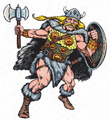Berserker: Difference between revisions
1d4chan>Nubnuber No edit summary |
1d4chan>Nubnuber |
||
| Line 17: | Line 17: | ||
Throughout [[AD&D]], the Berserker was a type of [[Human]] that appeared in [[Monster Manual]]s. They attack twice per round and automatically pass all morale checks. | Throughout [[AD&D]], the Berserker was a type of [[Human]] that appeared in [[Monster Manual]]s. They attack twice per round and automatically pass all morale checks. | ||
in 5e, they | in 5e, they are a [[barbarian]] light humanoid npc, having reckless attack. | ||
<gallery> | <gallery> | ||
Berserker MC1.jpg | Berserker MC1.jpg | ||
Berserker MM 2e.png | Berserker MM 2e.png | ||
</gallery> | </gallery> | ||
Revision as of 08:53, 26 March 2022
For the 40K unit, see Khorne Berzerkers.
The term Berserker comes from the Viking "Baer-sark", or "bear-shirt" (Snorri Sturluson argued that the correct translation was bare-shirt, as in not wearing a shirt, but most other historians do not agree with him). It referrs to dreaded warriors who, in battle, entered a sort of martial trance during which they seemed to be consumed with rage, fearless, immunized against pain and injury, and focused only on the butchery of their foes. Modern day researchers have described this as a state of hyper-adrenalized psychological compartmentalization that generally only forms in those who have suffered repeated emotional traumas in battle. In the modern day, these people would probably be institutionalized or undergoing extreme therapy. Other historians believe that this trance-like fury was brought about by the use of psychoactive drugs.
According to some legends, berserkers could transform into bears, similar to the Ulfsark or "Wolf-Shirt", who were believed to be able to turn into wolves, making them a possible origin for the myth of the werewolf. Similarly frenzied warriors appeared in many European Bronze and Iron Age cultures, like the Celts and Picts, with multiple sagas and poems explicitly using the word berserker. A 13th century Norse translation of a French story: "Yvain, Le Chevalier au Lion", translates the french word for champion into the Norse word for berserker, which gives it a secondary meaning.
Tabletop Gaming
Class
D&D's Barbarian class is based significantly on the concept of a Berserker. The Berserker in Pathfinder, and the Battlerager in 4th edition are Berserker-themed archetypes for fighters
3rd edition had the Frenzied Besererker Prestige Class, notorious for being a prestige classes that actually makes you worse for taking it compared to not leveling up at all. This "honor" puts it next to the Blighter (who loses all Druid abilities to slowly gain back inferior version), most Book of Exalted Deeds prestige classes (which saddle the character with massive codes of conduct with penalties for violating beyond loss of class features), and a few Monk-like prestige classes (Which remove your ability to use weapons). Frenzied Berserker gets on that list by having the main class feature entail losing control of their character and attacking allies, and made worse (even though the first part is bad enough to make that list on its own) auto-failing dexterity base skill checks (meaning it is stopped by ordinary marbles).
4th edition also has the Berserker as a Variant Class for the Barbarian, trading the Barbarian's features for a completely new set of features. Weirdly, it's not technically an "Essentials Class", as it still uses the AEDU System!
Monster
Throughout AD&D, the Berserker was a type of Human that appeared in Monster Manuals. They attack twice per round and automatically pass all morale checks.
in 5e, they are a barbarian light humanoid npc, having reckless attack.

